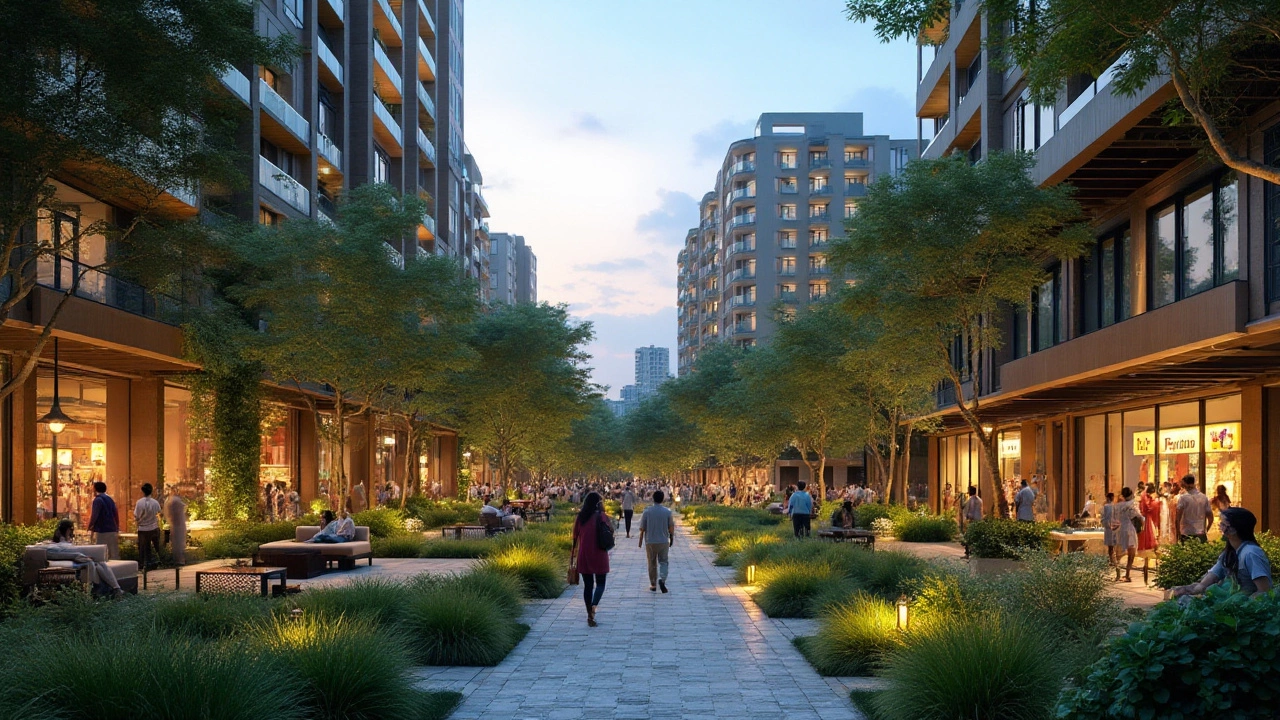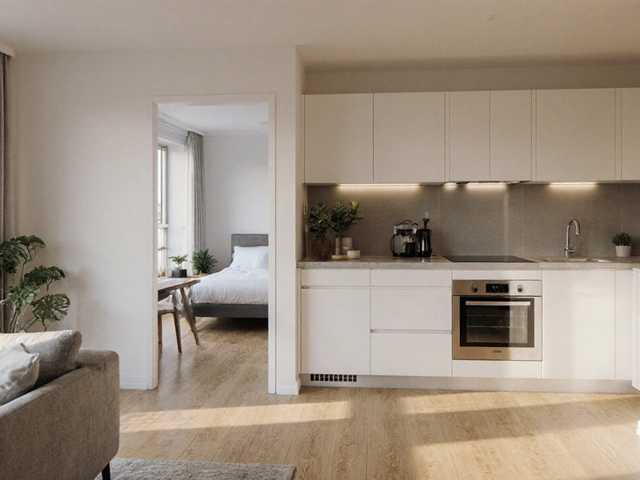Best Commercial Property Types for Investment

Investing in commercial real estate is a popular way to grow wealth and generate a steady income. Deciding which type of commercial property to invest in can be a complex decision, as it significantly impacts potential returns and risks.
Office spaces offer the stability of long-term leases, while retail properties can provide opportunities for high returns in bustling locations. On the other hand, industrial warehouses are seeing increased demand thanks to the rise of e-commerce. Lastly, mixed-use developments offer the advantage of diversity, combining residential, commercial, and sometimes even leisure spaces.
In this article, we'll delve into each type of commercial property, weigh their pros and cons, and provide insights on how to make a wise investment choice.
- Understanding Commercial Property Types
- Office Spaces: Steady Income
- Retail Properties: High Foot Traffic
- Industrial Warehouses: Growing Demand
- Mixed-Use Developments: Versatile Opportunities
Understanding Commercial Property Types
The world of commercial property is vast and varied, encompassing an array of buildings each offering unique opportunities and challenges. Investing in real estate for the commercial sector requires not just financial acumen, but also an understanding of market dynamics, tenant needs, and location specifics. From the gleaming skyscrapers housing offices to the bustling malls that attract shoppers in droves, commercial properties are the backbone of modern business.
One crucial factor in commercial real estate is recognizing the different types of properties available. Each type caters to different business needs and risks. Office buildings, for instance, are a traditional choice for investors seeking long-term stability. They tend to provide consistent rental income and are typically located in urban centers or business parks. However, they require continuous upkeep and a watchful eye on a fluctuating job market which influences demand.
Retail properties, on the other hand, are often found in either high-traffic urban areas or suburban locations. These can range from strip malls to large shopping complexes. While the advent of online shopping has challenged this sector, successful retail spaces often have an anchor store that draws foot traffic. The key to retail success lies in location and tenant mix.
Industrial spaces, including warehouses and distribution centers, have seen a surge in demand, largely fueled by the e-commerce boom. These properties are generally valued for their storage and logistics capabilities. The growth in online shopping has continued to bolster this segment, as more distribution points are needed to meet consumer demands quickly. Location near major transportation hubs is critical, as it can significantly affect operating costs.
"The industrial real estate sector is thriving with e-commerce growth expanding rapidly, proving a sound investment," according to Real Estate Visionary Magazine.
Mixed-use developments provide a unique investment angle by blending commercial with residential or hotel components. These properties offer diversity by maximizing land use and creating a vibrant community feel. Investors drawn to this type often appreciate the versatility and reduction of risk, as they are not reliant on a single revenue stream.
The key to mastering the nuances of commercial property investment lies in understanding these types, assessing their potential returns, and evaluating their risk levels. Each type of property has its market behavior, influenced by economic shifts and technological advancements, creating an evolving landscape that investors must navigate wisely.
If we delve into some real numbers, consider the average return rates for these sectors. Studies show that over the last decade, retail properties averaged a return of 9%, industrial properties were at the forefront with around 10%, office spaces at 8%, and mixed-use developments, though variable, often hit around 7%. These numbers provide a tangible glimpse into the potential the commercial property market holds.
Office Spaces: Steady Income
Office spaces continue to reign as a staple in the world of commercial property investment, offering the allure of a steady income stream. Businesses of all sizes require a base of operations, and with the ever-evolving nature of workspaces, meeting their diverse demands can ensure a stable occupancy. Investors are often attracted to office buildings due to the potential for long-term leases, which help provide consistent, predictable cash flow—something that cannot be undervalued in uncertain times.
In urban areas, particularly, office spaces in prime locations tend to secure reputable tenants willing to commit to lengthy lease agreements. These agreements can range from three to even ten years, ensuring that the property owner is receiving income over these periods without the frequent tenant turnover seen in other commercial property types. But this isn't to suggest that office investments are devoid of challenges. The rise of remote work and hybrid models has undoubtedly shifted demand patterns, pushing some investors to rethink traditional office settings. Yet, a well-located office space with adaptable designs might mitigate these concerns.
An interesting trend to note is the growing emphasis on eco-friendly and wellness-oriented office environments. Tenants are increasingly seeking spaces that offer sustainability features, such as energy efficiency and improved indoor air quality. These features not only attract potential renters but also boost the property's market value in the long run. According to a recent study by the Urban Land Institute, green-certified office buildings can command higher rents and have lower vacancy rates than their conventional counterparts. This highlights the importance of staying ahead of market trends to optimize returns on investment properties.
"The office market is transforming, but that doesn't mean office spaces are less relevant," says John Smith, an analyst at XYZ Realty. "Instead, it's about adapting the workspace to match evolving business needs—those who can stay flexible will be the ones to thrive."
Additionally, considering the location of the office space is crucial. Proximity to public transportation, available parking, and nearby amenities such as dining and retail spots can enhance the appeal of an office space. Therefore, when scouting for potential office spaces, these locational advantages should remain top of mind. It's equally vital to evaluate the general economic health and growth prospects of the area, as areas with a burgeoning business ecosystem could yield greater returns.
Ultimately, when deciding to invest in office spaces, prospective buyers should conduct thorough due diligence. From understanding the current demand and supply metrics in the region to ensuring that the architectural integrity of the property meets modern standards, each step is crucial. Seeking guidance from local real estate experts can also be invaluable, as their insights provide both market forecasts and strategic advice tailored to specific goals. With the right blend of insight and action, delving into the realm of office spaces can prove to be both a rewarding and exciting endeavor for investors.

Retail Properties: High Foot Traffic
When it comes to investing in commercial property, retail spaces are a compelling choice, especially those in locations with high foot traffic. These properties often capitalize on bustling pedestrian paths and thriving commercial districts, drawing in customers and boosting potential sales. Whether it's a quaint coffee shop on a busy street or a sprawling shopping mall, the success of these retail properties largely depends on footfall, making location a critical factor. One of the key reasons investors are drawn to retail spaces is the potential for community engagement. A well-positioned retail space not only attracts customers but also fosters a sense of connection within the community, becoming a regular stop for locals. As consumer habits shift, retailers that can create memorable shopping experiences stand a better chance of maintaining strong foot traffic and achieving robust sales.
The dynamics of retail properties have evolved significantly in recent years. The line between physical and digital shopping continues to blur, requiring retail spaces to innovate and offer experiential services that online platforms can't provide. This might include themed events, interactive displays, or personalized customer service. Despite the growing e-commerce trends, physical retail spaces are far from obsolete; they remain a tangible, sensory way for customers to experience products before making a purchase. Furthermore, with brands increasingly adopting omnichannel strategies—where customers engage through both online and offline methods—retail properties offer an essential touchpoint in the customer journey. According to a study by Deloitte, stores that seamlessly integrate face-to-face and digital interactions report higher customer satisfaction and retention rates.
For those looking to invest in retail properties, understanding tenant needs is paramount. Long-term leases usually stabilize income, but tenant flexibility can unlock additional revenue potential. As consumer preferences evolve, some retail stores might opt to reconfigure their spaces to accommodate pop-up shops or collaborative events. This adaptability is crucial in maintaining lease desirability. Additionally, both landlords and tenants benefit when the surrounding area thrives, as local developments can boost the attractiveness of the retail location. Prospective buyers should evaluate neighborhood growth indicators such as new infrastructure projects, rising employment rates, and increasing residential developments.
Let’s not forget the potential pitfalls of commercial real estate investment, which require diligent management. Retail properties in particular demand constant attention, as tenants might put significant wear and tear on the facilities. Careful planning is necessary to manage maintenance costs, and regular inspections help prevent minor issues from becoming costly problems. It's also wise to stay abreast of market trends, legislative changes, and economic fluctuations to anticipate market shifts that could affect occupancy rates or rental prices. Diversifying across various retail types—such as luxury boutiques, convenience stores, or specialized services—can hedge against downturns in specific retail sectors. As retail investor and author Richard Hurd notes,
“The location of a retail property often indicates its success as much as—or perhaps more than—the business inside it.”
In the final analysis, investing in retail properties offers exciting opportunities for those willing to navigate the dynamic landscape of consumer behavior and market trends. By choosing the right property in a vibrant location, balancing tenant relationships, and adapting to technological advances, investors can harness the potential of high foot traffic areas to achieve rewarding returns.
Industrial Warehouses: Growing Demand
The surge in e-commerce has dramatically increased the demand for industrial warehouses, making them a prime choice for real estate investors. As online shopping continues to grow, companies are constantly seeking large storage spaces to house their inventories. This trend is not limited to major corporations; smaller businesses are also contributing to the rising need for efficient logistics solutions. Beyond retail, sectors like manufacturing, technology, and pharmaceuticals are also expanding their warehouse capacities to streamline operations and increase storage efficiency.
With the shift towards same-day and next-day delivery as standard service offerings, the geographical positioning of warehouses plays a vital role. Investors often focus on properties located near major transportation hubs or within a short distance of urban centers. This strategic placement can significantly impact shipping times and costs, making it attractive for potential tenants. Additionally, some investors are exploring the conversion of older facilities to meet modern-day needs, which may include sustainable features like solar panels or energy-efficient lighting, further driving their appeal.
Real estate experts have noted the sustained growth in industrial real estate development over the past decade. According to the National Council of Real Estate Investment Fiduciaries, industrial property returns have outpaced all other commercial real estate sectors since 2010. This consistent performance makes warehouses a highly attractive investment opportunity in today's market. As David Kessler, managing partner at CohnReznick, aptly said,
“Industrial warehousing has been the resilient hero of the real estate world, adapting swiftly to the rapid shifts in consumer buying habits.”His perspective reflects the industry's potential and resilience even amid economic uncertainties, offering investors a reliable foothold.
For investors considering a foray into this booming property type, there are essential factors to weigh. Facilities with advanced technological infrastructure, such as high-speed internet and automated inventory systems, are preferable. These features ensure efficiency and competitiveness in a rapidly evolving industry. Prospective buyers should also consider the flexibility of the warehouse space to accommodate various tenant needs, including customizable loading docks, adjustable racking systems, and flexible lease terms.
The rise in industrial warehouses aligns with broader logistical advancements, such as the proliferation of supply chain technology and automation. Investors should stay informed about developments in areas like robotics, IoT for warehousing, and even the potential impacts of driverless transport. Keeping a finger on the pulse of technological innovation will help guide investment decisions and partnerships with tenants seeking cutting-edge facilities.
In summary, industrial warehouses represent a growing segment of the commercial real estate market with sustained demand fueled by the upward trajectory of e-commerce and logistical advancements. The strategic location, adaptability for technological evolution, and potential for sustainable enhancements position these properties as a viable investment avenue worth exploring.

Mixed-Use Developments: Versatile Opportunities
Mixed-use developments have become one of the most sought-after investments due to their dynamic blend of residential, commercial, and sometimes even recreational spaces. Investors are increasingly drawn to these multifaceted properties as they offer diversified revenue streams and create vibrant communities. By integrating various types of uses in one development, these properties attract a diverse set of tenants and visitors, significantly reducing vacancy risks.
One of the most attractive features of mixed-use developments is their capacity to leverage locational advantages. Often situated in urban centers or thriving suburban areas, they capitalize on high foot traffic and accessibility. This is particularly attractive for retail and dining establishments looking for visibility all while providing convenience for residents who enjoy amenities right at their doorstep. Retail spaces in a mixed-use property can cater to a residential population while drawing in external visitors, enhancing sales opportunities for businesses.
Moreover, the synergy between different elements in a mixed-use development can also drive up property values over time. The presence of commercial properties such as retail stores and restaurants often boosts residential desirability, as inhabitants enjoy the ability to shop and dine without needing to travel far. A development that includes office spaces may provide even more advantages by allowing for a live-work-play environment. Such offerings not only increase the attractiveness of the property to potential tenants but also enhance the overall market value of the property.
In terms of investment strategy, mixed-use developments tend to require more intricate planning and greater initial capital compared to single-use properties. However, the long-term returns can be substantial. Real estate investors must consider the balance between the various elements of the property to ensure that the integration results in synergies rather than conflicts. Proper management and a well-thought-out design are critical for maximizing the potential returns of these investments.
"Mixed-use developments are the future of urban growth and sustainability," says Jane Jacobs, a renowned urbanist whose work has been pivotal in shaping how cities are planned.
| Component | Typical Percentage |
|---|---|
| Retail | 25% |
| Residential | 40% |
| Office | 15% |
| Recreational | 10% |
| Others | 10% |









Write a comment